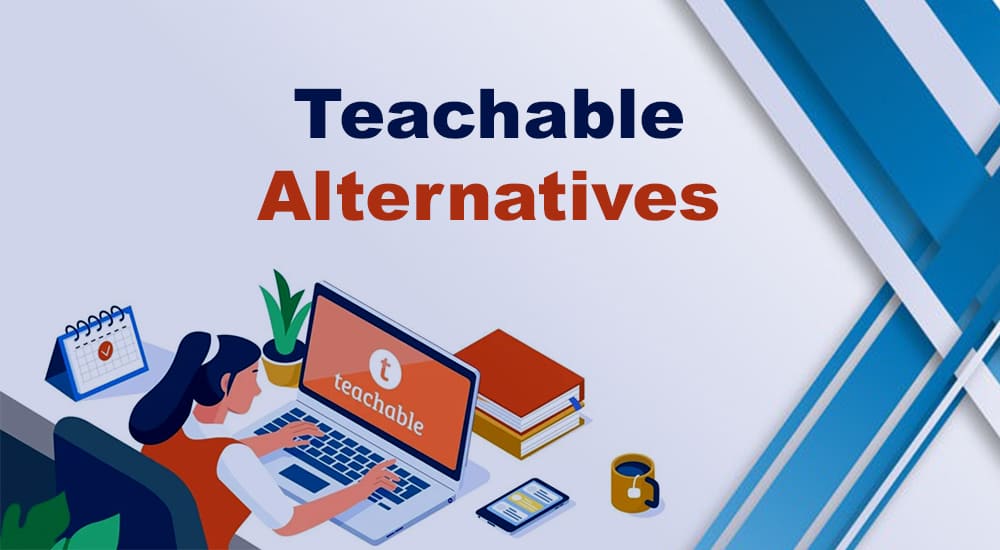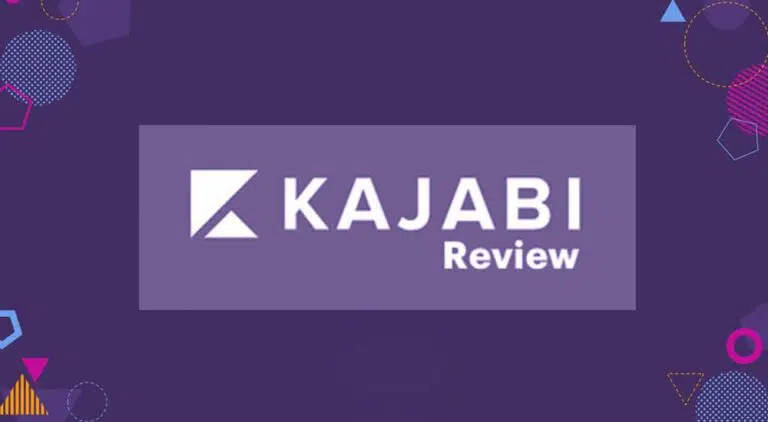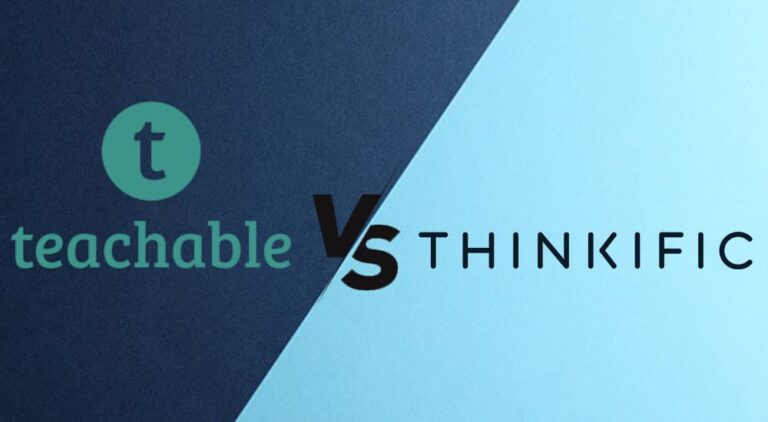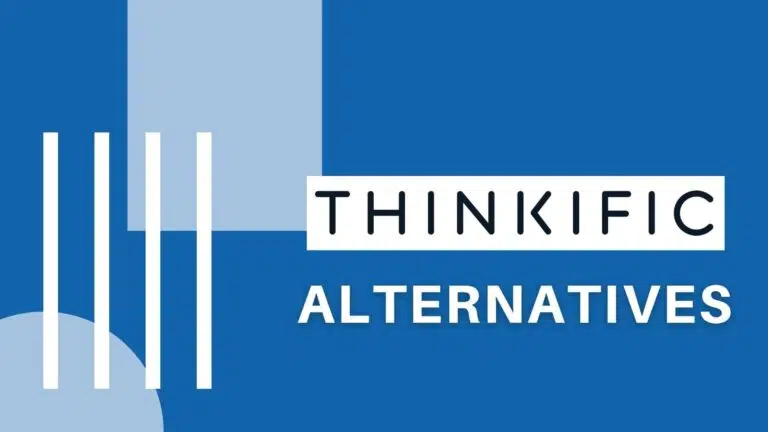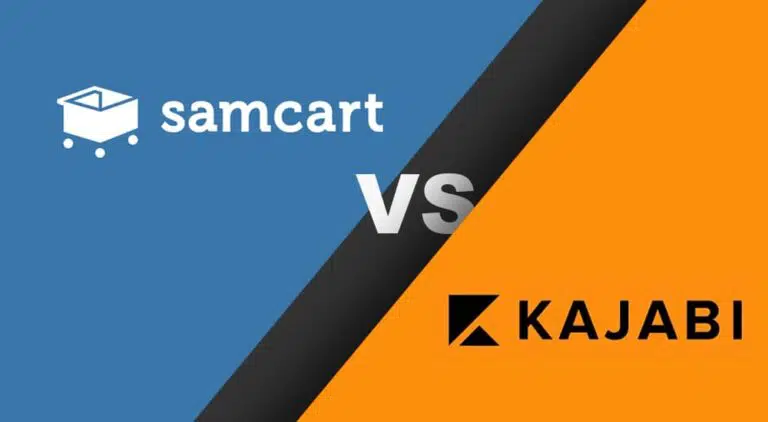Welcome to this Teachable Alternatives Post.
Teachable is one of the most popular online course creation platforms. However, if, for any reason, you do not like Teachable and are looking for an alternative, you landed at the right place.
So, without wasting time, let us learn about the seven best Teachable alternatives.
7 Best Teachable Alternatives
- Thinkific
- LearnWorlds
- Kajabi
- Podia
- LearnDash
- GuruCan
- FreshLearn
#1. Thinkific

Thinkific was founded in 2012 by Greg Smith, his brother Matt, and other co-founders Matt Payne and Miranda Lievers.
Thinkific is a popular Learning Management System (LMS) used by thousands of course creators. Some well-known users of Thinkific are Shopify, Hootsuite, and Keap.
Read my Thinkific review here.
Key Features of Thinkific
Zero Transaction Fees
This feature makes Thinkific a better option than Teachable, as Teachable charges a 5% transaction fee on the basic plan and 10% plus 1 USD on the free plan.
Thinkific does not charge a transaction fee for any plans. This means your income remains with you.
Creating a Course
You can upload media files such as PDFs, text documents, videos, or audio files. You can also upload presentations and can even host live lessons.
The best part is that you can add your voice to presentation slides to explain concepts to students. This feature is called “Voice Over Presentations.”
For assessment, you can use Thinkific’s pass-or-fail quizzes, give assignments to students, take exams, or take surveys to receive student feedback. You can also create an in-course community where students can converse and learn together.
Thinkific allows you to import existing content from other LMS to their platform.
Payment Plans
Thinkific offers several options when it comes to pricing plans. They offer subscription plans, monthly payment plans, one-time payments, and free plans.
After Purchase Flow
If you use Thinkific, you can decide where your customers land after purchasing a course. You can design a thank you page, stop the purchase flow, or lead them to another landing page to sell another course.
Upsell
Thinkific allows you to upsell your courses. You can create an upsell, cross-sell, or sell bundles, add-ons, or other non-course items to students and increase your revenue.
With Thinkific, selling your courses to one organization or a particular group of people is possible.
Completion Certificates
Thinkific lets you create and provide course completion certificates to your students.
TCommerce
This feature is useful for you if you live in the US, UK, or Canada.
TCommerce is a native payment processor from Thinkific, so you will not need to integrate third-party payment processors like Stripe or PayPal to collect payments.
The payment process is seamless and works smoothly.
Teachable promises to make this feature available to other countries soon.
Other Features
Other features include integration with third-party tools and applications like Mailchimp, Infusionsoft, Google Analytics, and even Zapier, which opens up ways to integrate with over 3,000 applications.
You can offer discount coupons and set up products with Thinkific. You can also schedule your courses.
Additionally, you can integrate your courses with your website. If your website is on Wix, WordPress, Weebly, Squarespace, Virb, or a custom site, you can easily add your Thinkific courses.
Thinkific also allows you to add your custom domain to your courses. There is also a white-label feature to remove Thinkific branding.
Now let us look at the pros and cons of this Teachable alternative.
Thinkific Pros and Cons
Pros
- Offers free plan
- Paid plans are reasonably priced
- Offers zero transaction fees
- Offers software status page
- Includes drag-and-drop builder
- Allows you to bulk upload media
- Offers view of detailed reporting and essential insights
- Contains material support like blogs, training videos, and FAQs
- Has training academy
Cons
- The free plan allows you to create just one course, whereas Teachable allows unlimited courses in its free plan
- The basic paid plan consists of very limited features, forcing you to upgrade to more expensive plans to access other important features
Now, let us look at pricing plans.
Thinkific Pricing Plans

Thinkific offers a free plan with minimal features, allowing you to access and try the platform.
The platform has three paid plans: Basic, Start, and Grow, with monthly prices of 49, 99, and 199 USD, respectively.
These prices are for the monthly subscription. You get a 20% discount with annual plans.
To see the features offered in each plan, visit the pricing page.
The most expensive plan offers all features. However, Thinkific offers an affordable method to access more features. It has an add-on called the Growth Add-on, which costs 50 USD per month.
The Growth Add-on opens the door for features such as white label, bulk enrollment, selling courses to organizations, and more.
Besides all the plans and add-ons mentioned above, Thinkific has an Enterprise Plus plan for high-volume customers. You can contact the Thinkific team to find out more details.
Click here to visit Thinkific.
This concludes our review of Thinkific. Let us check out our next Teachable alternative.
#2. LearnWorlds
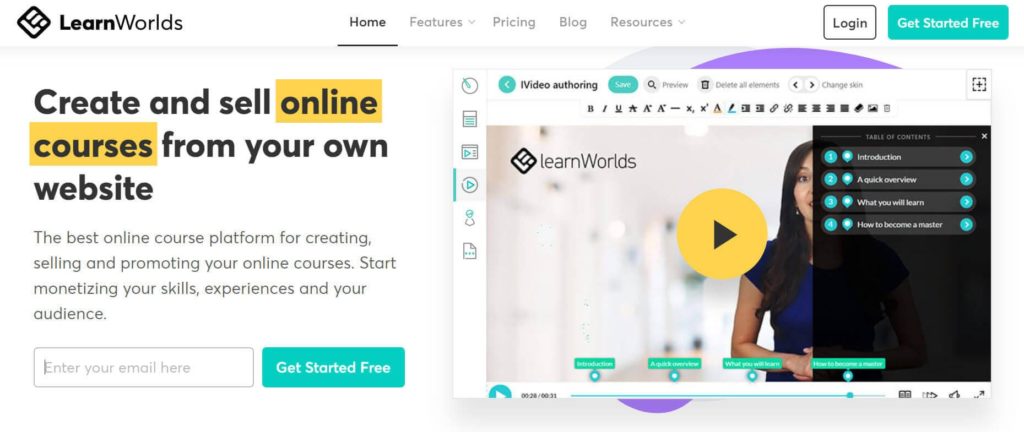
Second on the list is LearnWorlds. This online course platform is not as popular as Teachable or Thinkific, but LearnWorlds has the potential to be a competitor.
LearnWorlds is a Learning Management System founded in 1999 by three educators, Fanis Despotakis, George Palegeorgiou, and Panos Siozos.
Some popular brands that have trusted LearnWorlds are SendInBlue, Adidas, and Codefresh.
Read my LearnWorlds review here.
Key Features of LearnWorlds
Course Creation
LearnWorlds has one of the simplest and most user-friendly interfaces. Creating a course or acting is very easy. You can create a course in a couple of minutes in a few steps.
Whatever your plans are, you can upload your course content and files, set prices, make it live, or keep it in a draft. You get to create unlimited courses on LearnWorlds.
LearnWorlds also lets you drip-schedule your course. If you often have a particular date for scheduling your courses, that can happen if you use LearnWorlds.
School Website
Not only can you create courses in LearnWorlds, but you can also create a website for your school on a platform.
Website page creation needs no coding. All you need to do to create your site is click on the elements and build your pages. It is as simple as it sounds. You also have hundreds of templates to choose from.
There are widgets, color pallets, and font styles to help you create your website.
Apart from designing pages, you can localize your website in the language of your choice. Websites are focused on fast loading speeds and Search Engine Optimization (SEO) pages. Your web pages will be responsive to all screen sizes.
When you complete the website design, you can put your domain name in the URL, thanks to custom domain support.
Marketing Tools
Marketing tools bring us revenue. LearnWorlds comes with marketing tools such as one-click upsells (providing tempting offers to sell more products), cross-sells (suggesting other courses to existing students), and more.
With LearnWorlds, you get an advanced affiliate system that helps you manage your sales and commissions.
LearnWorlds also offers five major payment gateways: Shopify, Stripe, PayPal, 2CheckOut, and PagSeguro.
Mobile Learning (Mlearning)
LearnWorlds helps you create a mobile application for your course for iOS and Android in five steps. Simply sign up for LearnWorlds, create a course, build it with the visual builder, test your application, and publish it to the app store.
Analytics and Insights
To make data-driven decisions for your course academy, you need data. Visualizing data gives you the basis for making the right call for your business.
LearnWorlds has a reporting feature called “Reporting Center” that allows you to segment your groups, generate automatic reports, provide a detailed analysis of your user’s progress on each course, and provide course insights.
Support
LearnWorlds offers top-notch support. I am using this platform and always receive responses from support within hours.
You get a LearnWorlds academy, blog, help center, daily webinars, live masterclasses, free eBooks, and a 24/7 care team available at your service.
Integrations
This platform comes with a course’s fundamental needs like website, course creation, marketing tools, and analytics. However, you may need to connect to a third-party app.
LearnWorlds has not left any stone unturned and provides many third-party applications to integrate with, such as HubSpot, Mailchimp, Zoom, ActiveCampaign, Zapier, and more.
LearnWorlds Pros and Cons
Pros
- Mobile responsive course and mobile app
- Sleek interface
- Feature list includes a custom domain, white label, customizable templates, and more
- Customer support is helpful
- Hundreds of applications to integrate with
- European Union-General Data Protection Regulation (EU-GDPR) compliant
- Sharable Content Object Reference Model (SCORM) support
- Offers free trial
Cons
- Does not offer free plan
- Transaction fee included in its starter plan
LearnWorlds Pricing Plans
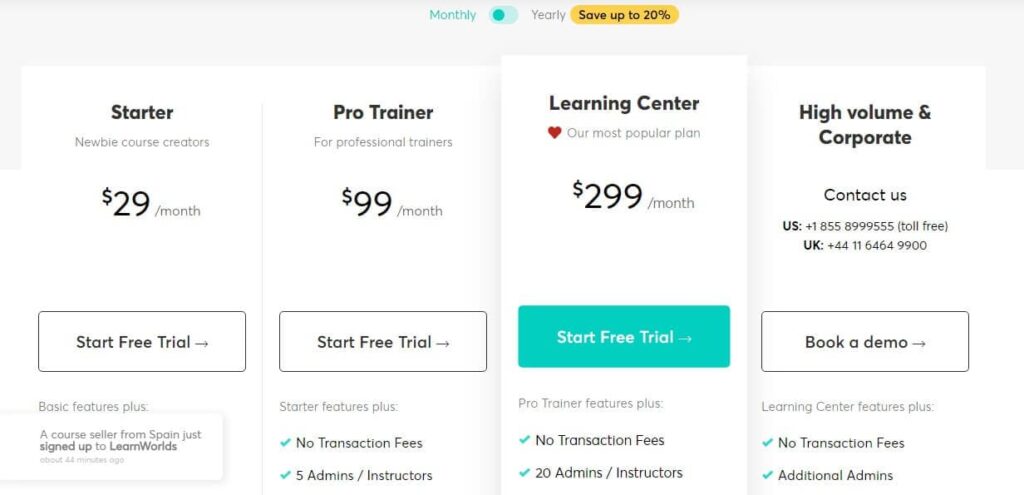
LearnWorlds has three pricing plans, including Starter, Pro Trainer, and Learning Center which start at an individual price of 29, 99, and 299 USD per month. It also has a Corporate plan for meeting high-volume needs. You can contact LearnWorlds customer care to find out the cost of the Corporate plan.
LearnWorlds does not offer a free plan, but all paid plans have a 30-day free trial.
You can see each plan’s different features by visiting their pricing page. However, note that the Starter plan charges 5 USD for every course sold.
Click here to open your account with LearnWorlds.
Let us move on to the next Teachable competitor.
#3. Kajabi
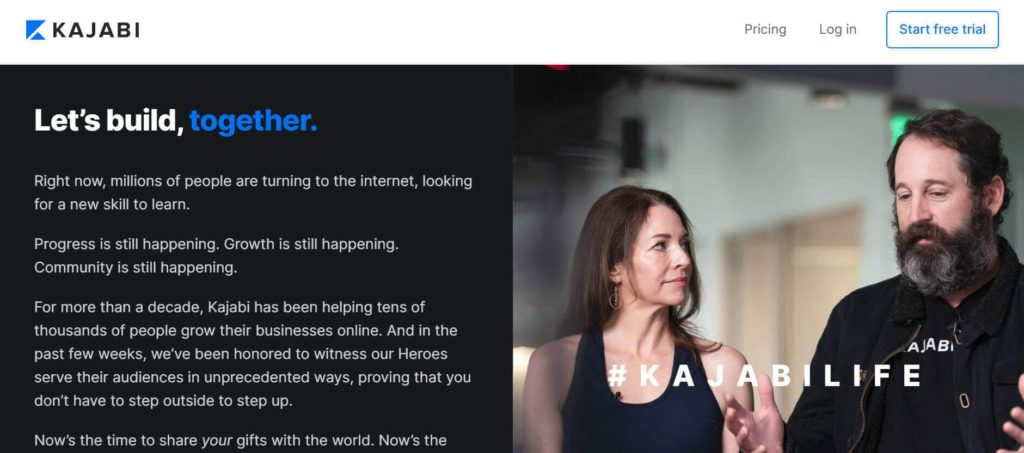
Kajabi is the third Teachable alternative on our list. It is a course-creation platform founded in 2010 by Kenny Rueter and Travis Rosser and it is led by CEO Ahad Khan.
Kajabi is one of those course creation platforms that does not just help create the course but also markets your courses, which makes more money for you.
It is similar to a sales funnel platform and provides a complete solution.
Like Teachable, Kajabi is a popular and loved software among course creators. Over 60 million students from 120 countries have purchased Kajabi courses from over 100,000 course creators, making them worth over 3.5 billion USD.
Kajabi has also been included five times in the Inc 5,000 list of California’s fastest-growing private companies.
Some popular users of Kajabi are Amy Porterfield, Brendon Burchard, and Brian J. Dixon.
Key Features of Kajabi
Kajabi Products
Products are “things” that you can create in Kajabi. So, products can be courses, coaching programs, mini-courses, memberships, communities, and podcasts.
Kajabi Website
Once your courses are ready, Kajabi will host your products and showcase them to your audience. It provides you with the tools to create a website to display courses.
It also has a custom domain feature to put your domain on the site pages.
Kajabi has a drag-and-drop builder so that you can design with ease. You get many website templates and can then amend the design using available elements such as timers, media, blocks, and more.
Kajabi Pipelines and Email Marketing
Pipelines are steps to achieve a predefined goal, and Kajabi lets you create pipelines.
Kajabi also offers many pipeline templates. You are provided with a pipeline canvas where you can design your pipeline with a drag-and-drop editor.
Along with course creations, Kajabi has a built-in ability to perform email marketing, unlike its counterparts that depend on third-party email marketing service integrations.
You have access to email templates that are easy to edit with the drag-and-drop editor.
You can send broadcast emails, create email campaigns, and spread awareness of your building.
Other Features
Kajabi integrates with many applications, including Mailchimp, ClickFunnels, and 100 more applications, with the help of Zapier integrations.
When you access Kajabi, you will see a “People” tab in the settings panel. Kajabi lets you manage your contacts, affiliates, or members. This feature helps you perform bulk actions on your contact list, which saves you time.
Kajabi not only assists you in creating a website but also allows you to design your checkout page. It has many elements to design the pages, such as order bumps, testimonials, calls-to-action, and more.
Kajabi provides decent resources and support to its customers. You have help centers, one-to-one activation calls, live chat, email support, and blogs for Kajabi communities and universities.
Kajabi Pros and Cons
Pros
- Zero transaction fees
- Offers free trial
- Courses are mobile responsive
- Platform is easy to navigate
- Can integrate with 100+ third-party applications
- Marketing features are helpful
- Provides software status page with good uptime
- Available as a mobile application
- Material support is exceptional
Cons
- Unlike Teachable, Kajabi does not offer a free plan
- It is expensive
Kajabi Pricing Plans
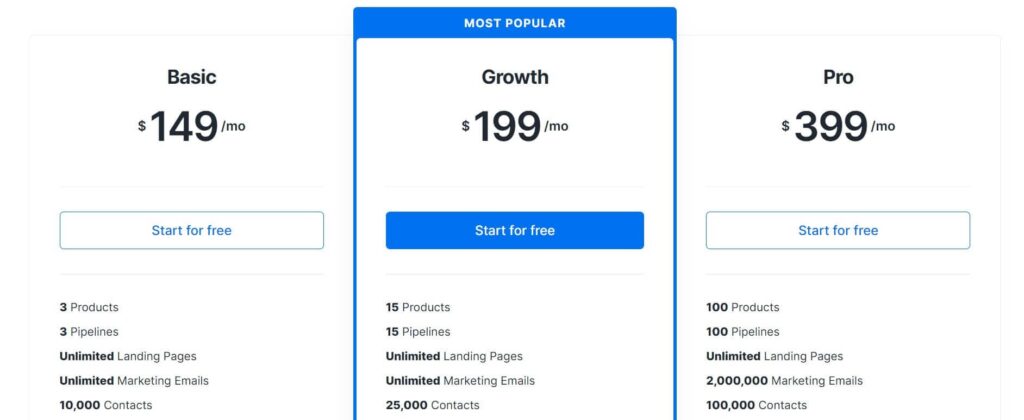
Kajabi has three pricing plans which include Basic, Growth, and Pro. It does not have a free plan, but all paid plans offer a 14-day free trial to give users a hands-on experience with its features.
The paid plans are priced at 149, 199, and 399 USD per month. You get a 20% discount on an annual subscription.
Each plan has some restrictions, as shown in the image above.
Kajabi may appear expensive; however, you are provided with email marketing features and course platform features, which justify higher prices than its competitors.
#4. Podia
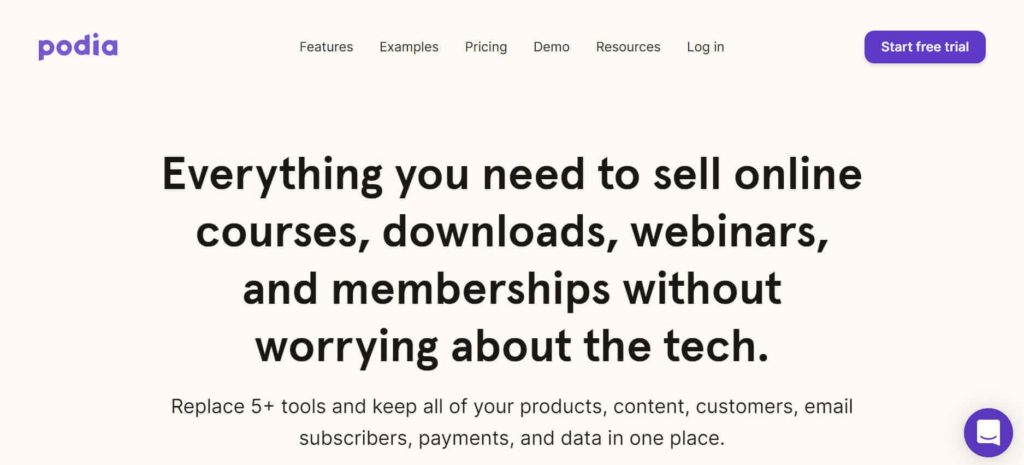
Podia is next on the list, which is a platform that helps you create and market courses.
Podia was founded in 2014 by Spencer Fry. In just eight years, Podia has gained the trust of over 50,000 course creators.
Key Features of Podia
Online Courses
You can upload content files that include videos, audio files, images, MP3s, PDFs, text, and more.
Podia also allows you to drip-schedule your courses, like the platforms mentioned above. Not only that, but you can also pre-sell your courses and launch them later.
You can also create several courses and sell them as a package.
Multilingual
Podia supports languages other than English. The languages you can set for your sites and products are French, Italian, Spanish, Dutch, Hungarian, Swedish, Portuguese (Brazilian), German, Spanish (Mexico), Russian, and Danish.
Not only that, but Podia also supports twenty currencies besides USD, some of which are EUR, CAD, GBP, and SGD.
Integrations
If you use Podia, you can connect with over 1,900 third-party platforms.
Podia Pros and Cons
Pros
- Does not charge a transaction fee
- Supports completion certificates
- Pages are suitable for all devices
- Features include custom websites, custom domains, marketing tools, upsells, coupons, and digital downloads
- Has an affiliate program
- Provides users with helpful blogs, guides, and videos
- Simple interface
- Offers free trial
Cons
- No mobile app
- Mediocre reporting
Podia Pricing Plans

Podia has a free, and three paid plans called Mover, Shaker, and Earthquaker.
The prices of the three plans listed above are 39, 89, and 199 USD per month. Annual plans offer a 17% discount.
Now let us move on to the next Teachable alternative.
#5. LearnDash
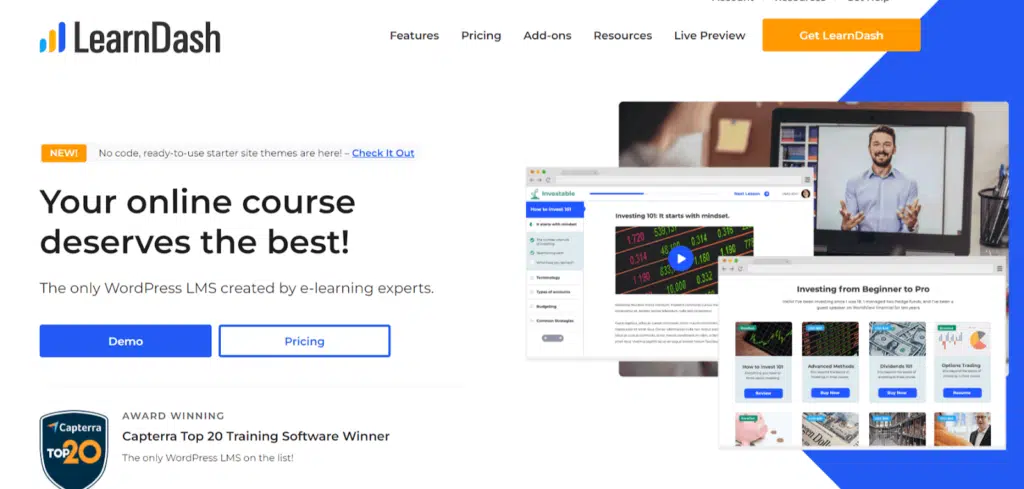
Now, we will review LearnDash. LearnDash is a WordPress LMS plugin that fills the need for a course platform for WordPress users.
Justin Ferriman founded this WordPress LMS in 2013.
Key Features of LearnDash
Online Course
You can create lessons using the drag-and-drop editor and include media and content in each lesson. You can also add assignments and quizzes to keep track of a student’s progress and provide certificates for your students after they complete the course.
Pricing Models
With LearnDash, you can offer the pricing model you want for your courses, whether a one-time payment, subscription, or bundle. You also get support from payment gateways like Stripe and PayPal and over 300 gateways with WooCommerce.
Integrations
You do not need to worry about connecting with your other favorite tools in LearnDash because it provides connections with Slack, MailChimp, SamCart, and Zapier.
Support
LearnDash has done a decent job of providing material support to its customers. Guided blogs, live webinars, video tutorials, help desk, detailed documentation, and a Facebook community are all available to users who need support.
Pros and Cons of LearnDash
Pros
- Offers money-back guarantee
- Courses come with certificates
- Integrates with over one hundred applications
- Mobile-responsive
- Provides decent material-packed support
Cons
- Does not have free plan
- Does not offer free trial
- As a WordPress LMS, it requires technical skills
LearnDash Pricing Plans
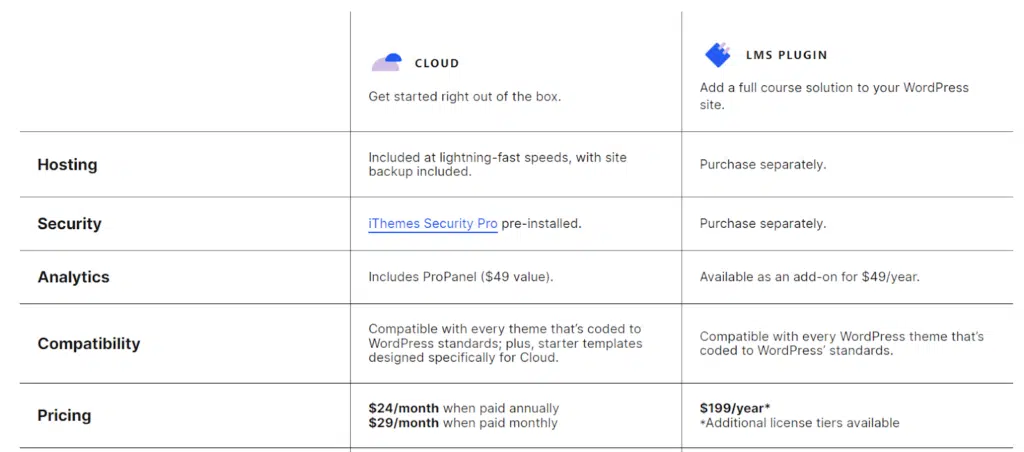
LearnDash has two pricing plans that include Cloud and LMS Plugin. This platform does not offer a free plan, nor does it offer a free trial. However, LearnDash does provide a 15-day money-back guarantee.
The three plans are set at 29 USD per month and 199 USD per year. Unlike other software platforms, you do not get a monthly plan for the LMS Plugin plan
#6. GuruCan

At number six, we have a brand new LMS called GuruCan, founded in 2019 by Dmitrii Egorov and Timur Chernenko. Let us look at its features.
Key Features of GuruCan
Course Builder
Firstly, you can create unlimited courses in all of its plans. You can pack your courses with video lectures, quizzes, and webinars. Additionally, all courses are accessible both on mobile and desktop.
GuruCan also allows you to create mobile-friendly sales pages.
Marketing Tools
This new LMS lets you send marketing emails to your students within the platform. You can send emails and push notifications to grab your students’ attention.
GuruCan Pros and Cons
Pros
- Charges no transaction fees
- Offers a free trial that does not require a credit card
- GDPR and California Consumer Privacy Act (CCPA) compliant
- Provides status page.
- Provides both iOS and Android mobile application.
- Allows you to build a mobile application, but it is expensive.
Cons
- Does not offer a free plan
- Short feature list
- Expensive considering the features it provides
GuruCan Pricing Plans

GuruCan does not have a free plan. Instead, it has three paid plans: Expert, Pro, and Guru at 99 and 149 USD per month and TBD.
When you subscribe to the annual plan, GuruCan reduces its prices to 82.50 and 125 USD per month.
#7. FreshLearn

The last software on our list, FreshLearn, is a new LMS in the industry that was founded in 2020. Since then, it has helped more than 7,000 creators earn over 10 million USD.
Key Features of FreshLearn
Course Builder
This platform does not require coding, so you can easily create courses. FreshLearn supports video hosting and video embedding from players like YouTube and Vimeo. It also allows documents, audio files, and live streaming. You can upload assignments and quizzes and provide students with certificates.
Payment Gateways
FreshLearn supports popular payment gateways like PayPal, Stripe, and RazorPay. You can sell your courses and make transactions easy with the help of these payment gateways.
Payment Options
FreshLearn gives your students the flexibility they might need by providing subscriptions, one-time payments, or a free trial.
Other Features
FreshLearn allows you to drip your content and gives you tools to design your pages. You can upload content in any language you prefer and customize the field text with the language of your choice.
You can also create coupon codes for your courses, and this platform can be integrated with over one hundred third-party applications.
For support, you get a knowledge base and FreshLearn academy.
Pros and Cons of FreshLearn
Pros
- Offers a free plan
- Does not charge transaction fees on paid plans
- Provides reasonable pricing plans
- Offers free trials
- Simple interface
Cons
- Charges a 9% transaction fee with free plan
FreshLearn Pricing Plans
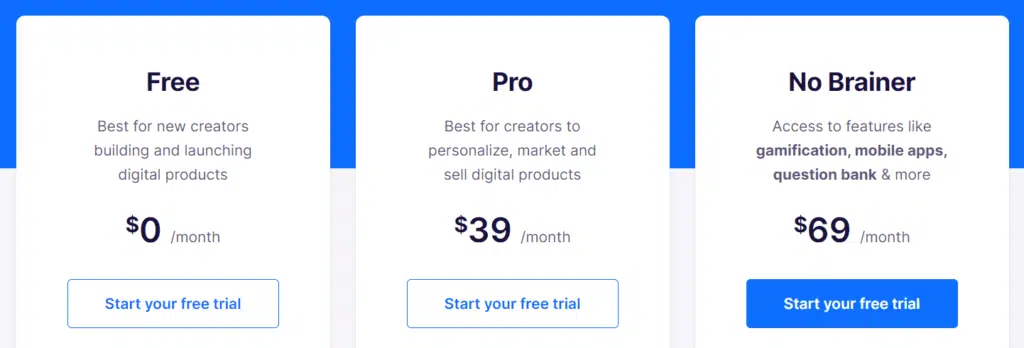
The pricing plans are pretty straightforward. FreshLearn offers a free plan that provides basic features and charges a 9% transaction fee.
Besides the free plan, two paid plans, Pro and No Brainer, offer very reasonable pricing, as shown in the image above. Rates are 39 and 69 USD per month, with a 40% discount when you subscribe annually.
Why You Will Need a Teachable Alternative
Although Teachable is a great course management platform, it has some shortcomings that can force you to look for alternatives.
Some reasons to look for alternatives to Teachable are:
Course Building Process: I have used several LMS platforms and can say Teachable is not the easiest platform to create a course. A beginner will need time to understand and use the platform efficiently.
SCORM Support: If your courses are in SCORM format, you cannot host them on Teachable as it does not offer SCORM support.
2CheckOut Integration: If you live in a country where Stripe does not offer its services, you are limited to PayPal, which limits your sales. In this case, 2CheckOut can save you as it has more coverage than Stripe. Teachable does not offer 2Checkout integration, but LearnWorlds does.
White Label Feature: Teachable does not offer a complete white label feature, even in the top-tier plan. A buyer can see the Teachable URL on the checkout page. Other platforms offer complete white-label websites.
Customer Support: Teachable does not offer live chat support, while some platforms offer this feature.
Concierge Migration: Many other platforms offer concierge migration from other platforms, but it is not included in any Teachable plans.
Other Teachable Alternatives
The above mentioned Teachable alternatives are course management platforms and offer similar features. These platforms are specialized in providing course management features.
However, they lack other sales funnels and marketing features.
If your course requirements are simple and you have robust marketing features, you can consider some sales funnel platforms. These platforms provide basic to intermediate LMS features and robust marketing features.
Some of these sales funnels’ platforms are:
- Systeme.io
- Simvoly
- Kartra
Systeme.io
I highly recommend this platform because it is a sales funnel platform that provides almost all features in the free plan.
It has the most generous free plan, and paid plans start from 27 USD per month to 97 USD per month.
The free plan has almost all the features you need to create your membership site, and paid plans are affordable.
Click here to visit Systeme.io.
Simvoly
Simvoly is another sales funnel platform that provides you with features to launch your membership site.
Though Simvoly does not have a free plan, its paid plans are affordable. The paid plans start from 18 USD per month to 179 USD per month.
All plans offer live chat support, with some limitations, and you get almost all the features in all plans.
Kartra
Kartra is one of the most popular sales funnel platforms with every feature you need to run your business. You can use Kartra to launch your membership site if your budget allows it.
It has a modern platform and intuitive builder to design websites, landing pages, and course pages.
Click here to Try Kartra Trail for 1 USD.
Which is the Best Teachable Alternative?
If you are looking for a platform similar to Teachable, I would say Thinkific is the best Teachable choice as it offers similar features.
LearnWorlds is another Teachable alternative. It has the best course builder compared to any other platform discussed in this post.
I have been using LearnWorlds for many years for our school and have never faced any issues. It has many unique features not offered by other platforms and offers a complete white label platform.
Teachable Alternatives FAQs
Q1: What is the difference between Teachable and LearnWorlds?
LearnWords provides Native SCORM and 2Checkout support, which is unavailable in Teachable. On the other hand, Teachable has native payment integration and an email marketing solution.
Q2: What is the difference between Teachable and Thinkific?
Thinkific provides enterprise-level features such as Service Level Agreements (SLA) and advanced password security, which helps medium to large businesses scale their learning experience.
Q3: What is the difference between Teachable and Udemy?
Udemy is a revenue-sharing platform and has an audience. They sell your course with their audience, affiliate marketing, and share the revenue with the creator.
Q4: Does Teachable offer a Trial?
No, Teachable only offers a free plan to test its services, which is why they do not offer a free trial.
Q5: Does Teachable offer a money-back guarantee?
On annual plans, Teachable offers a 30-day money-back guarantee.
Conclusion
All platforms mentioned in this post are the best Teachable alternatives. You should identify your requirements and select the platform which suits your needs.
However, LearnWorlds is the best Teachable alternative, and Thinkific is the second-best alternative.
Disclosure: Some of the links above are affiliate links, and I will earn a commission if you purchase after clicking. Please understand that I recommend these resources because they are useful, not because of commissions. Please do not purchase unless you feel that the materials will help you achieve your goals. Thank you for your support.

